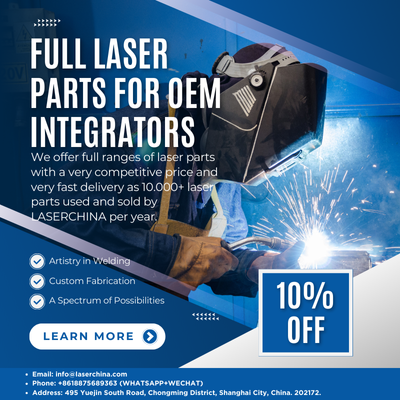Notifications

8 minutes, 6 seconds
-95 Views 0 Comments 0 Likes 0 Reviews

China has established itself as a leader in manufacturing laser welding machines, which have become essential in industries requiring high precision and efficiency. Laser welding is a process where focused laser beams are used to melt and fuse materials together, offering numerous advantages over traditional welding methods. Chinese laser welders, due to advancements in technology, cost-effectiveness, and high production volumes, have made a significant impact on the global welding industry. Below, we explore the key benefits, technological advancements, and how Chinese laser welders have influenced the welding landscape.
Precision and High-Quality Welds:
One of the most significant advantages of using a Chinese laser welder is the precision it offers. Laser welders deliver a concentrated energy beam that allows for incredibly accurate welding. This results in clean, high-quality welds, which is particularly important for industries like electronics, medical devices, and aerospace. Traditional welding methods like TIG and MIG tend to create larger heat-affected zones, increasing the risk of warping, distortion, and imperfections in the weld. In contrast, the small heat-affected zone in laser welding preserves the material's structural integrity, reducing the likelihood of defects.
Speed and Efficiency:
Laser welding is known for its speed and efficiency. Chinese laser welders are designed for high-speed operations, making them ideal for industries with high production demands. Unlike traditional methods, which require multiple passes to achieve a strong weld, laser welding can often complete the process in a single, quick pass. This efficiency translates into lower labor costs and higher throughput, ultimately improving overall productivity. In mass production environments, such as automotive manufacturing, laser welders enable fast, automated welding that keeps pace with assembly lines.
Minimal Heat Input and Reduced Distortion:
Laser welders apply energy in a very focused manner, resulting in minimal heat input to the surrounding material. This leads to less thermal distortion, less warping, and reduced chances of affecting the material’s mechanical properties. In contrast, traditional welding methods generate more heat, increasing the likelihood of material changes or structural issues. This precision in heat control makes Chinese laser welders especially useful for delicate and high-performance materials like aluminum, titanium, and thin sheets of stainless steel, where any distortion can lead to significant problems.
Versatility in Welding Materials:
China's laser welders are versatile and capable of welding a wide range of materials, from metals to certain plastics and ceramics. Laser welding machines can join dissimilar materials, such as aluminum to steel, which is a challenge for many traditional welding methods. The ability to weld both thin and thick materials with high precision makes laser welders suitable for a diverse set of industries, including automotive, electronics, medical, and aerospace.
Automation and Integration:
Modern Chinese laser welders come with advanced automation capabilities, which allow them to be integrated into production lines for continuous operation. Automation not only enhances productivity but also reduces human error, ensuring consistent and high-quality results. Many Chinese manufacturers offer customizable solutions, such as robotic arms and automated loading/unloading systems, that further enhance the capabilities of laser welding equipment. Automation ensures that laser welding is cost-effective, even for smaller batch productions, due to the reduction in labor costs and the ability to operate continuously.
Fiber Laser Technology:
China has been a significant player in the development and adoption of fiber laser technology, which has revolutionized the laser welding process. Fiber lasers provide higher energy efficiency, faster processing speeds, and greater precision compared to traditional CO2 lasers. Fiber lasers also have a longer lifespan, which makes them cost-effective in the long run. Chinese manufacturers have led the charge in refining fiber laser technology, making it more affordable and accessible to industries around the world.
Laser Beam Shaping and Control:
Recent advancements in beam shaping and control technologies allow Chinese laser welders to provide even more precise and customized welding. Laser beam shaping enables the creation of different welding profiles, optimizing the process for specific applications. This technological development has made Chinese laser welders highly adaptable to various welding requirements, such as deep penetration welding, surface welding, and fine-detail work.
Cooling Systems and Power Efficiency:
China has developed advanced cooling systems for laser welders, which help manage the high heat produced during the process. These systems ensure that the machines operate efficiently without overheating, thereby extending their operational life. Moreover, power efficiency has been significantly improved, reducing energy consumption and operational costs. This is a key factor in making Chinese laser welders competitive on the global market, especially for industries looking to minimize their carbon footprint.
Chinese laser welders have had a transformative effect on the global welding industry. By offering high-quality machines at a competitive price point, Chinese manufacturers have made advanced laser welding technology more accessible to businesses of all sizes. This has democratized the use of laser welding, allowing smaller companies and manufacturers in developing countries to adopt cutting-edge technology that was once only available to large enterprises.
Furthermore, the affordability of Chinese laser welders has encouraged innovation in various industries. Companies can now experiment with different materials and welding techniques, leading to new applications and improved products. For instance, the automotive sector has benefited greatly from the introduction of laser welding in car body assembly, allowing for stronger and more lightweight components.
China’s laser welders have brought significant advancements to the global welding industry. With their precision, efficiency, and versatility, they have become indispensable in industries ranging from automotive to aerospace. The combination of technological advancements and competitive pricing has made Chinese laser welders a popular choice for companies worldwide, helping to elevate manufacturing standards and push the boundaries of what is possible in welding technology. As Chinese manufacturers continue to innovate, we can expect laser welding to become even more integrated into global production processes.

